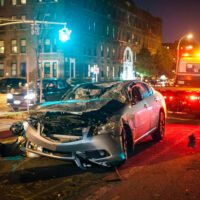Who Is At Fault For a Multi-Car Pileup?

When more than one passenger vehicle, motorcycle, or truck is involved in a crash, it is known as a multiple car accident, commonly called a multi-car pileup. It really doesn’t matter whether there is a three-car accident, a four-car accident, or more automobiles involved in the crash. It is still a multi-vehicle accident.
There are various types of multiple car crashes. Rear-end accidents, intersection collisions, and lane change-related impacts are among the most common types of multi-vehicle accidents.
The probability of death and serious injuries in such “chain reaction” collisions is proportional to the number of vehicles and individuals involved. It may be challenging for emergency responders to reach the injured and get them to the hospital. In multi-car pileups, there is a greater likelihood of a gas leak, leading to higher chances of fire or explosion.
Determining liability in a multiple car pileup is not as straightforward as identifying the vehicle with the most damage. The fault, ultimately, must be established on an individual case basis. However, there exist some general principles that will help. To begin with, you will need to look at the individual motorist’s actions and the type of multi-vehicle crash that occurs.
Multi-Car Pile-up Accident Example
Driver Z –> Driver Y –> Driver X –> Driver W
Driver X strikes the car in front of him, which is being operated by Driver W. As Driver Y was tailing Driver X too closely and could not halt on time, Driver Y also ends up rear-ending Driver X. Behind Driver Y, the same situation occurs with Driver Z being unable to stop in time to prevent a rear-end collision with Driver Y. Further, the force of the collision between Driver X and Driver W could send Driver W’s car forward into the next car in line, leading to another chain reaction.
Chain reaction crashes may involve many motorists who were each acting recklessly (at least to a certain degree). Thus, bringing a vehicle insurance claim or personal injury lawsuit over these types of collisions may be complicated. Some issues that may arise, particularly when establishing liability, in vehicle accident cases involving chain reaction collisions are as follows:
Determining Liability for the Accident
Upon filing an insurance claim or case against another driver after a chain reaction crash, you will likely need to prove responsibility under a legal theory known as “negligence.” Determining which motorist was negligent largely depends on which driver’s recklessness caused the crash. If more than one motorist was careless, then each driver’s share of liability must be established.
An essential rule of the road is a critical element in a majority of chain reaction crashes-drivers must leave following space between their car and the car in front of them. Doing so can help them stop in time to avoid any unanticipated situations and road hazards, such as the car in front of them, stopping abruptly. Any motorist who does not maintain a safe following distance and subsequently rear-ends the lead vehicle will almost always be considered reckless.
But what happens when your vehicle is slammed into the car ahead of you because you got rear-ended yourself?
Irrespective of how a chain reaction car crash plays out, various sources can help you identify the order of impacts and who was negligent. These sources include the following:
- Eyewitness statements (including your own account, those of the occupants of each car, bystanders, and the motorists of the vehicles behind you)
- Police reports on the crash, including the findings of the reporting officer as to whether any motorist committed a traffic infraction
- Vehicle damage
- Proof collected at the accident site, including vehicle debris and skid marks
Car Crash Investigation
A multi-car accident lawyer uses sophisticated technology and leading experts to establish who is at fault for an accident. They will meticulously examine any available camera footage of the crash as well as locate and question eyewitnesses, including motorists and their passengers.
The lawyer reviews the police report thoroughly and checks to see if any driver statements have changed since the incident. The initial statements may all point toward the “the other driver,” which is not unusual or unexpected. The more evidence your lawyer can gather showing you were not responsible, the better outlook for your claim.
You’ll want to get photos and video footage of the crash scene. However, these crashes can quickly grow out of control and involve more and more vehicles. For that reason, it’s important to take photos from a safe distance. Ensure that you get photos of all involved vehicles and, if possible, their license plates.
You should also have photos that capture the road and weather conditions if they contributed to the collision. Try to get photos that may be useful in determining fault, such as photos of skid marks, damaged guardrails or medians, or knocked-over signs.
Finally, you must get contact and insurance information for everyone involved. It doesn’t matter if there are entirely innocent parties—you still need to get their information.
Legal Help for Multi-Car Pile-Up Accident Victims
After a multi-vehicle pileup accident, it may not make sense to try to manage your own vehicle insurance claim or personal injury lawsuit, particularly if your injuries are serious or the other party is trying to place the sole responsibility of the accident on you.
If you or someone you love has been injured in a pileup or another car accident type, please consult the legal experts at John H. Ruby & Associates. Our lawyers have the credentials, skills, qualifications, experience, and resources to investigate your accident and ensure that you get fair compensation.
We work on a contingency fee basis for personal injury claims, and you will not be paying anything unless and until we accomplish a financial recovery in your case. Call (502) 895-2626 today for a free initial consultation.
